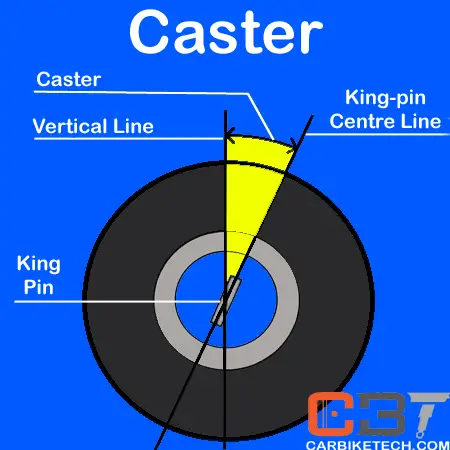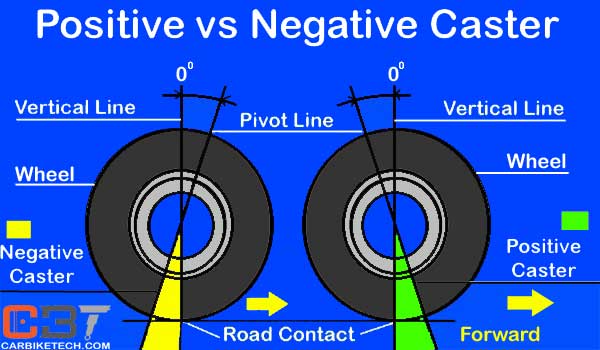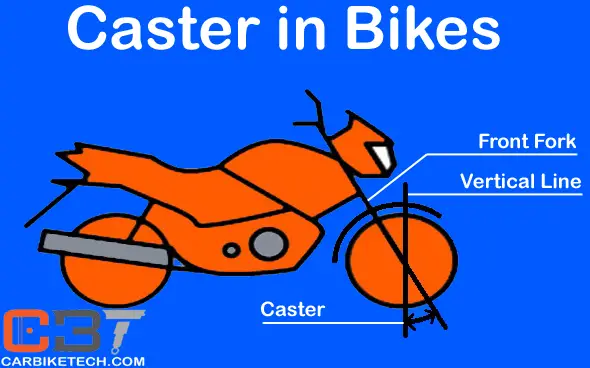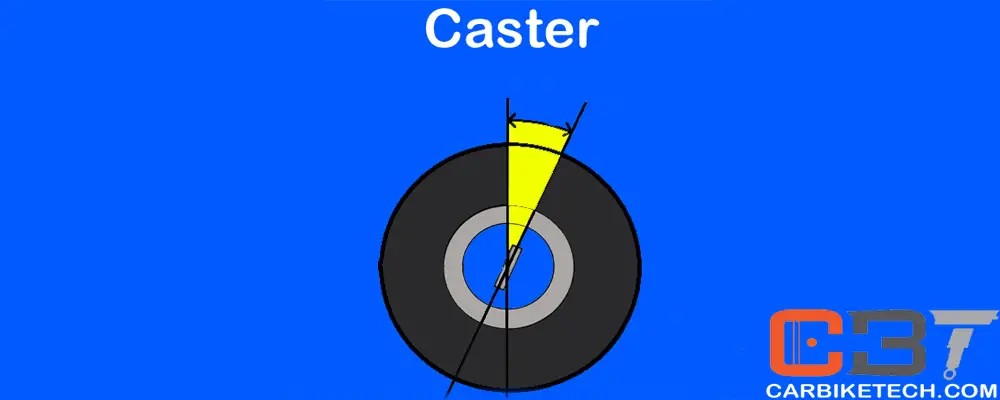What Is Caster angle?
Automotive manufacturers design the suspension systems to provide ease of steering and directional stability. To attain this, the wheels must lead or follow in the same direction as the vehicle. This is obtained by the caster angle in the front suspension. Further, it is also necessary that steering maintains a straight path. It should also straighten out or self-centers automatically after the turn.

This self-centering effect is achieved by tilting the king-pin from the top. For this, the king-pins (in rigid suspension) or ball-joints (in independent front suspension) slightly tilt from the vertical line. The angle between the king-pins or ball-joints center line and the vertical line forms Caster angle as seen from the side.
Furthermore, tilting the top end backward i.e. against the direction of the travel of the vehicle produces a positive (+) casterangle. However, tilting it forward i.e. towards the direction of the travel produces a negative (-) caster. In other words, if the projected line passing thru’ the king-pins or ball-joints falls ahead of the vertical line, it forms ‘Positive Caster’. However, the same line falling behind the vertical line forms ‘Negative Caster’; both viewed from the side. (See the diagram below)

Technically, the negative caster is the opposite of the positive one. Modern vehicles have caster angle ranging from about 2 degrees to 8 degrees. Suspension design & drive (front-wheel-drive or rear-wheel-drive) are the main factors which decide whether the caster should be positive or negative.
Advantages:
Caster affects the directional stability of the vehicle. It causes the wheels to wheels to lead or follow in the same direction as the vehicle. Caster acts in the same way as in the furniture wheel does. It creates the tire contact either behind or ahead of the direction of the extension of king-pin or ball-joint center-line.
Caster angle provides directional stability, and ease of steering. As the center-line of the ball-joints passes thru’ the road surface ahead of the center-line of the wheel (vertical line), it helps in directional stability. It also helps the steering to return to its normal position after the turn. Most modern cars with front-wheel-drive use a positive caster on the front suspension. The rear suspension on some cars also has a caster. You can adjust caster on some modern cars with independent rear suspension.
Two-wheelers and Motorcycles:
Two-wheelers such as scooters & motorcycles also have the caster angle. The angle between the forks/shock absorbers center and the vertical line forms the ‘Caster’ angle in motorcycles. It varies for different types of motorcycles. However, in most cases, it is fixed and is not adjustable.

King-pin inclination vs Caster:
Caster angle forms when the steering axis line crosses the road contact ahead of the vertical line. However, steering axis inclination is the line passing thru’ the center of the king-pin/ball joints that tilts inwards (towards the center of the vehicle). The stub-axle center rotates along the axis of the ball-joints (or king-pin) center-line.
With caster, its center goes up & down from its axis while turning. When the center goes up, it tries to bring it back to its normal position; thus, helping the steering to return to its normal position. Caster is adjustable in independent suspension design. You can adjust it by the brake-rod which connects the lower arm to the chassis. However, it is fixed & cannot be adjusted in the rigid suspension/ king-pin design.
Watch Caster Angle in action:
Read more – What is Camber in cars? >>
